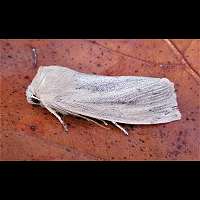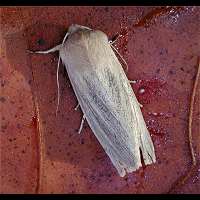Large Wainscot Rhizedra lutosa
The Large Wainscot belongs to a group of whitish to brownish moths having little markings. The wings often seem covered in black dust. The Large Wainscot is the largest species by far. When it comes to size however it is extremely variable and very small specimens do fly about. These may present you with a problem as they are similar to other Wainscots. You are safe by thinking that all Wainscots having wings with a length of 19mm or more are Large Wainscots. This leaves us with animals having a wing length of 16 to 18mm. The most similar species is Blair's Wainscot. It however is always smaller and may be eliminated easily. The Fen Wainscot is very similar too, but it doesn't show as much black dust as the Large Wainscot does. The wingspan of the Large Wainscot varies enormously between 36 and 52mm!
The eggs are being laid late in summer and in autumn, but they overwinter before hatching in spring. It is stated that newly hatched caterpillars eat from the shoots of the food plant before going inside the stem. Here they eat their way downwards to complete their development in the roots of the plant. Because of this very hidden life, not all details are known about the caterpillar's behaviour. Infested plants however suffer enormously. Usually their leaves turn white first, then become yellow and die. In June the caterpillars leave the root and burry themselves into the soil close to the roots. Here they pupate. The pupal stage lasts about 4 to 8 weeks depending on temperature. Like most larvae living inside of plants, fruits or wood the caterpillar of the Large Wainscot is whitish brown and the skin is almost transparent. Some internal organs may be seen through the skin. The spiracula are relatively large and black. The caterpillar reaches a length of 35 to 44mm only, but is rather fat and plump. The only known food plant is common reed.
The Large Wainscot is on the wing in August and September mainly. The last animals are seen by half October. They fly early in the evening at first, often when it isn't completely dark yet. Then they are regularly seen on sugar. After midnight they fly again to be attracted to light. Males are inclined to stay near the food plant, females are vagrant and may be encountered far away from reed. Animals caught at night are very good photographer's models by day and can be handled easily. The Large Wainscot may live in Common Reed only, it doesn't live in swamps and other very wet areas, for the roots must always be above water. It is most seen in reed away from water and in comparetively dry circumstances. Because of this it is a widespread, but local species all over the British Isles and Ireland. Even though it is known from the Hebrides and Orkney it becomes rarer and even more local going northwards into Scotland. On the continent it is a rather local species as well.
The Large Wainscot belongs to a group of whitish to brownish moths having little markings. The wings often seem covered in black dust. The Large Wainscot is the largest species by far. When it comes to size however it is extremely variable and very small specimens do fly about. These may present you with a problem as they are similar to other Wainscots. You are safe by thinking that all Wainscots having wings with a length of 19mm or more are Large Wainscots. This leaves us with animals having a wing length of 16 to 18mm. The most similar species is Blair's Wainscot. It however is always smaller and may be eliminated easily. The Fen Wainscot is very similar too, but it doesn't show as much black dust as the Large Wainscot does. The wingspan of the Large Wainscot varies enormously between 36 and 52mm!
The eggs are being laid late in summer and in autumn, but they overwinter before hatching in spring. It is stated that newly hatched caterpillars eat from the shoots of the food plant before going inside the stem. Here they eat their way downwards to complete their development in the roots of the plant. Because of this very hidden life, not all details are known about the caterpillar's behaviour. Infested plants however suffer enormously. Usually their leaves turn white first, then become yellow and die. In June the caterpillars leave the root and burry themselves into the soil close to the roots. Here they pupate. The pupal stage lasts about 4 to 8 weeks depending on temperature. Like most larvae living inside of plants, fruits or wood the caterpillar of the Large Wainscot is whitish brown and the skin is almost transparent. Some internal organs may be seen through the skin. The spiracula are relatively large and black. The caterpillar reaches a length of 35 to 44mm only, but is rather fat and plump. The only known food plant is common reed.
The Large Wainscot is on the wing in August and September mainly. The last animals are seen by half October. They fly early in the evening at first, often when it isn't completely dark yet. Then they are regularly seen on sugar. After midnight they fly again to be attracted to light. Males are inclined to stay near the food plant, females are vagrant and may be encountered far away from reed. Animals caught at night are very good photographer's models by day and can be handled easily. The Large Wainscot may live in Common Reed only, it doesn't live in swamps and other very wet areas, for the roots must always be above water. It is most seen in reed away from water and in comparetively dry circumstances. Because of this it is a widespread, but local species all over the British Isles and Ireland. Even though it is known from the Hebrides and Orkney it becomes rarer and even more local going northwards into Scotland. On the continent it is a rather local species as well.






